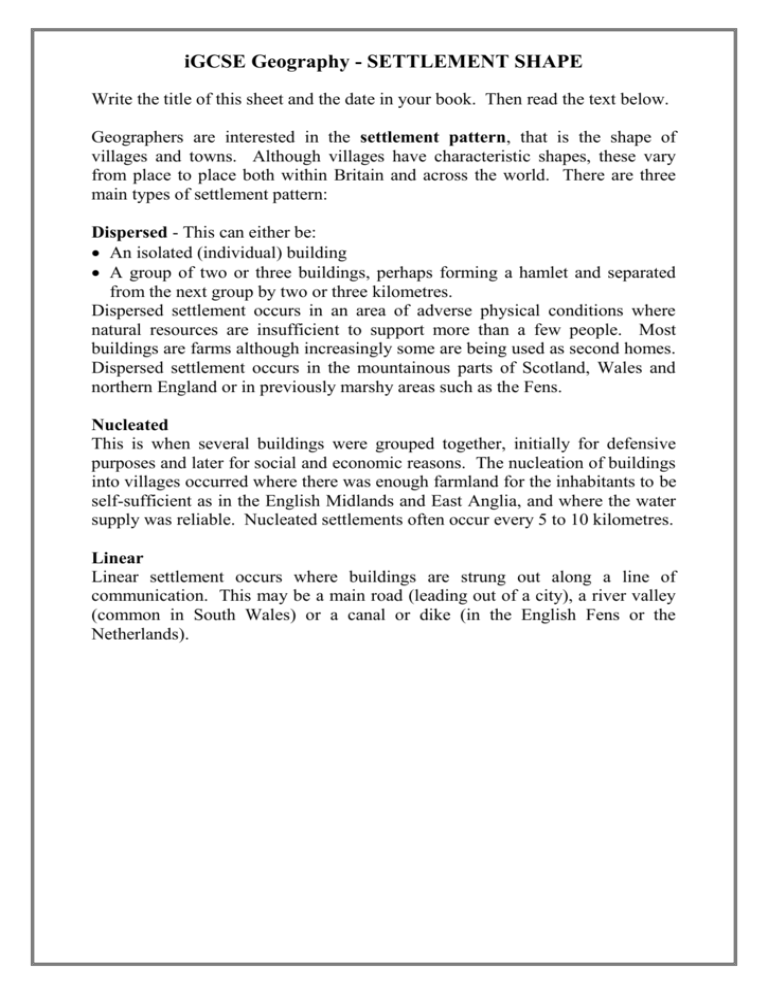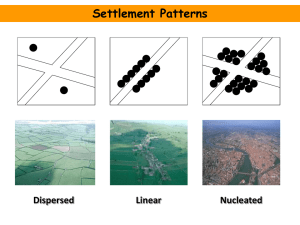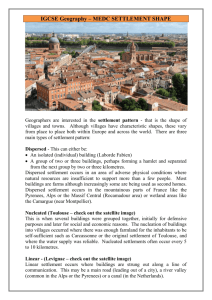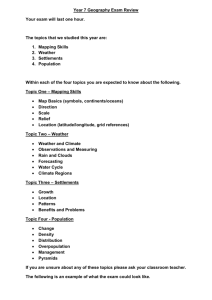settlement patterns worksheet
advertisement

iGCSE Geography - SETTLEMENT SHAPE Write the title of this sheet and the date in your book. Then read the text below. Geographers are interested in the settlement pattern, that is the shape of villages and towns. Although villages have characteristic shapes, these vary from place to place both within Britain and across the world. There are three main types of settlement pattern: Dispersed - This can either be: An isolated (individual) building A group of two or three buildings, perhaps forming a hamlet and separated from the next group by two or three kilometres. Dispersed settlement occurs in an area of adverse physical conditions where natural resources are insufficient to support more than a few people. Most buildings are farms although increasingly some are being used as second homes. Dispersed settlement occurs in the mountainous parts of Scotland, Wales and northern England or in previously marshy areas such as the Fens. Nucleated This is when several buildings were grouped together, initially for defensive purposes and later for social and economic reasons. The nucleation of buildings into villages occurred where there was enough farmland for the inhabitants to be self-sufficient as in the English Midlands and East Anglia, and where the water supply was reliable. Nucleated settlements often occur every 5 to 10 kilometres. Linear Linear settlement occurs where buildings are strung out along a line of communication. This may be a main road (leading out of a city), a river valley (common in South Wales) or a canal or dike (in the English Fens or the Netherlands). Figure 1: Idealised Settlement Shapes 1. Write a definition for the following terms in your book. Remember to use full sentences: a. settlement pattern b. dispersed c. nucleated d. linear 2. Using Figure 1 on the worksheet, complete the table below, showing the different types of settlement shape: Name of settlement shape Diagram of Reason for settlement settlement shape shape Abandoned village Dispersed rural settlement Semi-dispersed village Cross-shaped nuclear village Compact nucleated settlement Linear nucleated settlement Nucleated village green T-shaped nucleated settlement Nucleated village estate SETTLEMENT SHAPE Write the title of this sheet and the date in your book. Copy the text below into your book, filling in the blank spaces. There is a wordbox at the bottom of the sheet to help you. Geographers are interested in the settlement __________. This means the shape of villages and towns. There are three main types of settlement pattern: Dispersed - This can either be: An individual (__________) building A group of two or three __________ separated from the next group by two or three kilometres. __________ settlement occurs in an area which may have very hot or cold temperatures. They are also found in places where there are not enough __________ to support more than a few people. Most buildings are __________ although some are being used as second homes. Dispersed settlement occurs in the __________ parts of Scotland, Wales and northern England or in previously __________ areas such as the Fens. Nucleated This is when several buildings were grouped __________, initially for defensive purposes and later for social and economic reasons. This happened in places where there was enough farmland for the inhabitants to grow their own __________ and where the __________ supply was reliable. There are many examples of nucleated settlements in __________ and eastern England where they are situated 5 to 10 kilometres apart. Linear Linear settlement occurs where buildings are __________ out along a line of communication. This may be a main __________ (leading out of a city), a __________ valley (common in South Wales) or a __________ or dike (in the English Fens or the Netherlands). buildings canal central Dispersed farms food isolated marshy mountainous pattern resources river road strung together water Figure 2: Map Extract from Rural Norfolk, United Kingdom 1. Look at the shapes of the following settlements and choose the name on Figure 1 that best fits each one: Wickmere Matlaske Plumstead Aldborough Itteringham 2. Find an example of a hamlet and an abandoned village. 3. Find a settlement from the map that seems to be attached to large halls or manor houses? Why was this once common? 4. Are new housing estates attached to any of the settlements?







